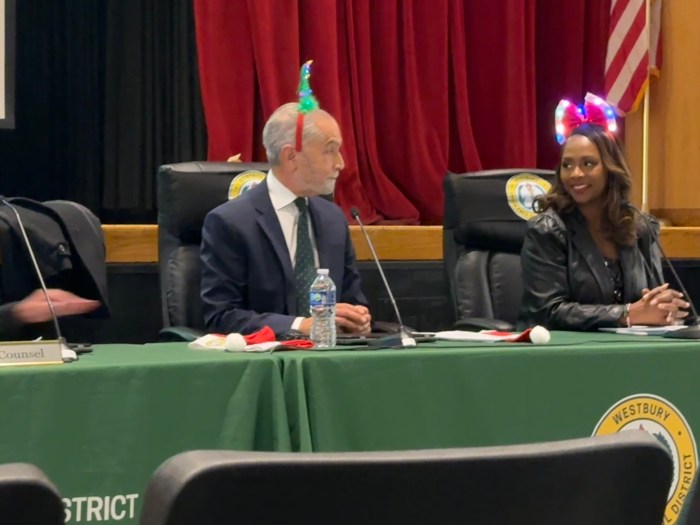
Transit-oriented development can add 1,600 housing units
Westbury recently took another step toward transforming one of its core areas.
A few days past the third anniversary of Governor Andrew Cuomo’s announcement that the village was the first community on Long Island to receive a Downtown Revitalization Initiative (DRI) grant, it presented for review its draft generic environmental impact statement (DGEIS) related to far-reaching amendments of its zoning code. Westbury will use portions of the DRI funding to make a significant change to its zoning.
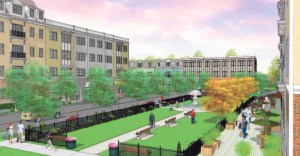
Mayor Peter Cavallaro and the board of trustees presided over a full house at village hall last month as consultants touched on the highlights of the DGEIS and what the zoning would mean for the village’s future.
The main component was the creation of the Maple Union Transit Oriented Development district to transform the nearly 50 acres bound by Union Avenue on the south, School Street on the west, Maple Avenue on the north and Post Avenue on the east.
Click here for more information on the DRI project and the DGEIS.
The aim is to create a mixed-use area featuring a range of housing adjacent to one of its greatest assets—the Long Island Rail Road station. The amended zoning would allow developers to erect housing that everybody agrees is in short supply on Long Island—for millennials just starting out and for seniors who want to downsize, but stay in the community. This influx would also have the effect of helping the current downtown business district centered on Post Avenue.

The acreage is currently mainly zoned industrial and light industrial, with a smattering of residences amidst a plethora of garages and trucking and construction firms. With apologies to the property owners from the target zone in the audience, Cavallaro said, “Not to denigrate those properties, but it really is the only degraded or underutilized portion of the village.”
Deep Analysis
Cavallaro said that after the village won the $10 million DRI grant, it created a Local Planning Committee to study how to best utilize the funding to carry out Governor Cuomo’s vision of “thriving downtowns that would transform villages, spur investments and create destination places.”
The village’s DRI Plan formulated the following vision: “Westbury will be Long Island’s model transit-oriented, diverse, walkable, arts-centric downtown.”

After months of meetings and analysis, the committee whittled down literally dozens of ideas to 12 for which it sought funding. Albany decided to finance seven of these.
“The zoning project that we’re hearing about tonight is one of the seven projects,” Cavallaro said. “I believe, and I think the board believes, that even though this rezoning project isn’t the biggest dollar project that we’re working on with the DRI process, it’s the most important as far as the future of the village. And it is truly the most potentially transformative of the projects that we have identified.”
Cavallaro said that even though Westbury has been and continues to be a village dominated by single-family homes, it had, in the past 10 or 15 years, seen a number of multistory, multifamily buildings erected that have added 800 units.
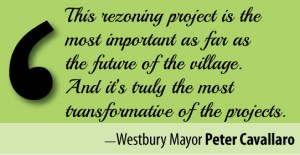 Many people did not realize this, he noted, mentioning the mix of condos, rentals and assisted living units within a few blocks of the railroad station and along the main routes.
Many people did not realize this, he noted, mentioning the mix of condos, rentals and assisted living units within a few blocks of the railroad station and along the main routes.
“They’ve been seamlessly digested into the community and they help make some of the fabric of the community what it is,” the mayor said.
He mentioned the usual villages that have undergone a renaissance in the past decade, thanks to transforming their downtowns: Farmingdale, Rockville Centre, Patchogue and Mineola.

“And if you look at those communities, you see a lot of success,” Cavallaro said. “They’ve attracted new residents, new businesses and their downtowns are vital and thriving. I think we have all the elements that are necessary to replicate some of those [successes]. I think we also have a unique position here because of our location, because some of the downtown revitalization has already been done in the last decade-and-a-half on and around Post Avenue.”
The mayor reiterated that the proposed rezoning would not a new downtown create.
“The idea here is not to create competition for our merchants who do business on Post Avenue,” Cavallaro observed. “Post Avenue is in pretty good shape. If you look at our main street and compare it to others, we have very, very few vacancies. The idea [with rezoning] is to create a new center of energy which will continue to feed and make Post Avenue healthy and keep it healthy and thereby keep the community healthy. And that’s what the idea of the whole project is.”
He feels the potential development promised by rezoning is the best way to make Westbury sustainable for the future and upcoming generations.
“We will receive the benefits if this project is implemented and if some of the developments are implemented because we are taxpayers and we do live here,” he said, “but it’s really for the long-term viability of this community and I’m excited about it.”
Lawyerly Talk
Cavallaro introduced the village’s special counsel for this project—Kevin Walsh, Matt White and Westbury’s own Laura Schaefer, who represents the village in the county legislature. He noted that Walsh “in particular has a tremendous amount of experience in transit-oriented development bracket, working in Farmingdale and Mineola doing this type of work.”

After briefly explaining the history and function of New York’s State Environmental Quality Review Act (SEQRA), Walsh said the public hearing that evening covered both the zoning changes and the DGEIS.
The latter, he noted, is when the state tells a municipality, “You have to look at all the things that might be affected because it’s a zoning change and we don’t know exactly who’s going to build what. You have to study this in the context of the worst case scenario that’s why VHB Engineering, with the help of other consultants, put together a very thorough document. And if you look through it, you will see that they discussed everything.”
He added, “Our job is to make sure that [the DGEIS is] done properly and that the zoning code is considered by the board properly so that when it is enacted by the trustees, it will be legal and proper—and it’s defensible.”
Turning to the proposed zoning, he noted that the density rises as it gets closer to the railroad station, as that’s where the bulk of the transit oriented housing will be situated. Also, to protect the existing Post Avenue commercial-retail district, no commercial establishments of any kind will be allowed in the vicinity of that main north-south thoroughfare.
As far as multifamily housing, the zoning would allow a limited number of commercial uses on the ground floor.
According to Walsh, “Those that have dealt with multiple dwelling housing and transit-oriented development find that they’re much more successful when buildings have some life going on after hours—[things like] personal services, coffee shops, dress shops [and such]. There’s a list of them that are going to be permitted there, subject to a special permit to the extent that they may be open late. If it’s just the residential area and it is dark completely in the evening, they tend not to work as well.”
Westbury, Walsh observed, “has significant assets. You have a functioning thriving downtown that a lot of places don’t have. You also have a train station, which believe it or not, really brings people into the area. They want to live there. They want to jump on the train to New York City and be back [easily]. These are the kind of people we generally like to have because they don’t drive around…they’re walking to downtown on the weekend to do everything they want to.”
Walsh concluded, “Overall, the proposed zoning amendments will facilitate a mix of retail, commercial and residential uses that will continue to bolster the economic vibrancy and enhance the quality of life for residents, workers and visitors. We really see these proposed [zoning] amendments as something that will provide not only consistent future development, but will [create] an harmonious, organic, cohesive downtown area. It would also diversify the housing options that will be available within the village and enhance the community character and aesthetics within the downtown.”
Traffic Flows
Frank Pearson, director of transportation safety at Greenman Pedersen, Inc. in Babylon, performed the traffic study for the DGEIS.
His firm evaluated seven intersections within the downtown area, three on School Street and another four on Post Avenue.
“The main goal was to determine how these streets operate today, and how will they operate in 2033, when the full build-out of the rezoning could be in place,” Pearson said. “And we looked at two conditions: one is the no-build, traffic would operate in 2033 without the zoning changes and how traffic will operate with zoning changes. We analyzed these intersections [using the] software program that is the standard that is used for evaluating traffic capacity. It provides a letter grade based on the operation. Grade A would have the least amount of delay and the highest level of service. It goes down to level of service F, which as you could imagine is a fail. It means that you are over capacity and your delays have gotten excessive.”
He went on to say that the overall grade level at the seven intersections is fairly good, and ranges from A to C. There were, however, some troublesome individual turn movements and approaches, especially during the morning and afternoon peak hours. One earning the F grade was the westbound left turn from Maple Avenue to Post Avenue. The turn from Maple east onto Post earned a grade of E.
The traffic flows improved under the scenario of full build-out under the proposed zoning, mainly because transit-oriented housing resulted in fewer cars,
Pearson acknowledged that, in the future rezoning scenario, mitigation measures will have to be taken to reduce congestion at certain times and certain intersections. Changing the traffic signal cycling time was one way to accomplish this, Pearson explained.
His firm also studied the parking situation under the rezoning scenario, and concluded that there would not be a parking shortfall; in fact, the study envisioned a parking surplus of 350 spaces.
Scaling Back
Eric Alexander of Vision Long Island, a consultant to this and many of the downtown transformations that have borne fruit, gave a presentation on how the initial zoning scenarios envisioned by the DRI—most crucially, number of stories and density per acre—had been scaled back after further review.
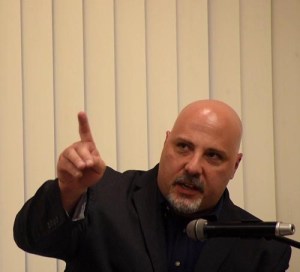
Originally, buildings could be up to seven stories in height. Under the proposed rezoning, the base height would be three stories, but the board of trustees could consider giving permission for up to five stories if the developer agreed to provide amenities sought by the village.
The density was reduced from 50 to 35 residents/acre while open space increased from 1.2 to 2 acres.
Alexander noted that private investment in the area was estimated at $351 million at full build-out, which calls for about 1,600 units of housing.
The planner praised the spirit of bipartisanship and cooperation that had characterized the whole process.
“The consensus was unanimous as far as the projects to move forward, but there were some comments made in the community throughout about the aggressiveness of the density, the building height, and the design of the buildings as they were preliminarily put forward,” Alexander observed. “Remember, the DRI is a state process with a grant that thinks big. You need to tailor it to the community—the architectural vernacular, the size, the scale, what really works for local folks.”
In Vision’s weekly newsletter days later, Alexander echoed some of what he had said at the meeting: “One of the reasons this project has fared so well has been the hyperlocal focus and local groups that came out to support including: the Westbury Arts Council, Westbury BID, and local religious institutions such as the Islamic Center of LI and many local residents and business.”
 After noting that these and other groups had been involved throughout the planning process of the DRI and had helped provide input, Alexander added that “there was significant communications with local property owners and also…from the development community about what’s buildable and what’s not. Because you don’t want to create a zoning code that doesn’t get us to a place where something doesn’t happen.”
After noting that these and other groups had been involved throughout the planning process of the DRI and had helped provide input, Alexander added that “there was significant communications with local property owners and also…from the development community about what’s buildable and what’s not. Because you don’t want to create a zoning code that doesn’t get us to a place where something doesn’t happen.”
He had had lots of experiences wherein “there was a great plan and the [rendering] pictures were pretty,” but nothing came of the projects.
Alexander also noted that some of the earlier plans with the DRI came out of a city-centric group of consultants (who were chosen by the state) “but now [we have] people who are hyper local in their thinking. There’s a real local flavor in all this And that’s helped with the unity.”
School Population
Alexander also discussed the impact of the proposed new housing on school enrollment. The Westbury school district, he observed, has bucked the trend on Long island by actually gaining student population.
“We had a special meeting with the school board members and staff and went over some of these preliminary numbers. We’re waiting for their feedback,” Alexander said. “We looked at this, not theories but actuals. We know there are projects on Long Island and similar communities that have transit-oriented development and multi-family developments and they’ve had minimal school children.”
The DGEIS noted that in the 1,800 total housing units erected in the villages that were studied, only 50 school-age children were living in them, resulting in a figure of .26 children per unit average in communities across Long Island.
Alexander emphasized that even though it is called multi-family housing, it’s really not build for children the way single-family houses are. He had been inside about 60 of these buildings, he added, and has seen very few children. He concluded that the impact on school enrollments been very very minimal.
Board Members Speak
Trustee Steven Corte said, “The one constant I find throughout all this, is that everything we see doing here is a positive for our future. And that’s very important for us. We need to know that this is sustainable going forward, that we got a good tax base, so we’re providing affordable housing for our residents, the downtown would be more prosperous and our tax base will be better—all the ingredients we need to sustain ourselves.”
Corte praised the effort put into developing the plan and praised the village’s staff and the consultants, as well as the mayor. He was also glad to see the level of participation from residents.
“It’s nice as a trustee to see the community come together and stay together over this length of time, and I hope it continues that way, and we build something together going forward,” Corte concluded.
Trustee Beaumont Jefferson praised the DRI and DGEIS teams, as well as the support from the community during the DRI process.
“This will be probably one of the most important initiatives I’ll be involved with as a village trustee,” Jefferson stated. “Obviously, the community has a lot of concerns they bring to you.”
He mentioned school enrollment, and was confident that even with the highest estimate of school-age children, the transit-oriented area would not have a significant impact on enrollment.
“This couldn’t have happened at a better time because we have the Third Track Project, which will eliminate the road crossing at School Street…and we have the train station beautification, which will help to attract more people,” Jefferson said, and also added that few people now live in the affected area and the new zoning will create additional affordable housing opportunities.
“All in all, I feel that it is a fantastic project moving forward,” Jefferson concluded, and looked forward to the job creation and economic development and additional property taxes resulting from the rezoning.
“I’m excited. This is great for the village,” said Trustee Vincent Abbatiello, who recalled, as a young member of the Westbury Fire Department, how he feared the delivery of liquid nitrogen to a now-shuttered semi-conductor facility in the light industrial area under review. If one of the delivery trucks ever exploded, he observed, “it would have wiped out half of Westbury.”
He said that the construction firms in the area are on board with the rezoning and are approaching the village with ideas.
“You’re bringing people into the community and they’re going to be spending money on Post Avenue,” Abbatiello said. “They’re going to be bringing tax revenue into the area. Let’s make it happen. And the public input from the village residents from the get-go has been tremendous. That’s why this room is the way it is tonight. It is packed. Everybody’s excited.”
The People Speak
The mayor then opened up the meeting to public comment.

Anthony Mastroianni, who has been practicing law in Westbury since 1978, called the rezoning, “The greatest milestone for the village since its incorporation in 1932. And why do I consider it the greatest milestone? Being a lawyer, totally familiar with the zoning code, I know that code was made to serve an agricultural community when it was adopted in 1932. We have changed since 1932. Long Island is no longer the potato fields and the duck farms that were here then.”
He went to praise the governor and mayor for recognizing the ideas needed “in order to enhance the ability of Long Island to become the economic force of the future and provide the amenities that are going to be needed by the workforce. What does this do for the Village of Westbury? It makes it a viable place to be for the economic future on Long Island.”
Virginia Shoureas wondered about the security in the rezoned area, and also the garbage removal, noting there is considerable litter there now.
“Those are good concerns,” Cavallaro replied. “I would respond to your first concern by saying that every proposal is going to have details as to how they’re going to police their own property, So if they have garage parking for instance, they’re going to have to have their own security measures on site to police and make sure that it’s safe and secure.”
He noted that the county is very encouraging of the project and is aware that future residents would need increased police patrols and protection.
As far as trash, Cavallaro affirmed that the zoning code would require the project developers and property owners to supply their own sanitation.
“That would allow us to enforce [the code] if they’re not properly disposing of their trash,” Cavallaro observed. “There will be no cost to the village residents [as far as additional solid waste expenses] because the property owners will be responsible for taking care of their trash.”
Shoureas said she’d been in Westbury since 1969 and, “I have never seen what I have seen this past year on Post Avenue. And it’s not positive. Twice this year I had to call the police for drunken men sleeping on the sidewalk during the day, and I saw a mother with a child having to walk around them.”
She had seen some of the renderings of what the rezoned area looked like, and was worried that the open space areas would draw people who drink.
Cavallaro responded, “We’ve had those issues in the past and we have an ongoing dialogue with the [Nassau County Police Department’s] Third Precinct.”
He added that police had to occasionally remove drunken people from the Piazza Ernesto Strada.
“Unfortunately, those type of things will occur,” he said. “It is a matter for the village government to work with the police department and our other elected officials to make sure it doesn’t happen. The idea here is to upgrade the entire area [and by doing so] we are hoping to stimulate more upgrade and vibrancy on Post Avenue. “I think the best thing there is for having that type of activity not to happen is a lot of activity by people who are there legitimately going to a restaurant or show or whatever. And people who are wont to be drunk don’t want to be in that environment. It’s up to the village to work with the police department [to control] that kind of conduct.”
“You shouldn’t rely on someone walking down the street like myself to call 911,” Shoureas pointed out. “I think the people coming in today—I don’t care how fancy your restaurants are, if they have to walk around [drunks on the sidewalk], they are not going to come back [or enter the restaurant].”
Faroque Khan of the Islamic Center said he had been in Westbury since 1984. and wanted to express his happiness at seeing Post Avenue thrive.
“As far as this project, I can assure you the members of the Islamic Center are looking forward to it,” Khan stated. “There’s a whole bunch of young millennials. There’s a whole bunch of seniors who are retiring who want to move out of those big homes and into some some more manageable places and they will endorse this completely. All I can say in conclusion is good luck and Godspeed.”
Cavallaro thanked Khan for his comments and added, “We have seen a large [cohort] here in the village where we have people who want to age in place and one of the incentives we are offering is for senior or age-restricted units, as well as units for millennials and veterans-preferred units. We know there’s a market for that.”
The mayor pointed out that these would be private transactions, not transactions the village will be putting together.
“But there are people in this room that own properties and they may be looking for investors to help them pull off a project,” he added.
Doug Omstrom, a former president of the Commercial Industrial Brokers Society of Long Island, said that Long Island’s largest commercial brokers group supports the village’s proposed rezoning.
Omstrom has been a resident of the village for more than 30 years and noted that the rezoning would help bolster businesses along Post Avenue, expand the tax base and keep the community sustainable in the long run.
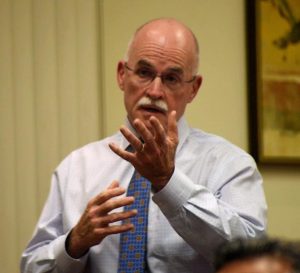
“Our members are in constant contact with many of Long Island’s most dynamic employers, both large and small. We hear their concerns, difficulties and needs” Omstrom said. “One area we often hear about is the difficulty in keeping our younger generation and talented local employees on Long Island. The obstacles that are faced are due to the lack of affordable, convenient and suitable rental housing, mass transportation options and walkable downtowns with amenities.”
He continued: “Transit-oriented construction and smart mixed-use downtown development is the future of a successful and prosperous Long Island. We already see its overwhelmingly positive effects in communities such as Huntington Station, Farmingdale, Patchogue and Wyandanch. Many other communities have approved or are considering transit-oriented, mixed-use projects. Examines are Lindenhurst, Ronkonkoma, Hicksville and Oceanside. In our view, the proposed Westbury transit-oriented development fits in well with our mutual goals to create jobs, spur private investment, help ease the local tax burden, improve our overall business climate and ad needed transit-oriented, smart mixed-use development in our community.”
Margaret Cosenza asked about the bonuses that would enable developers to build higher than the basic three stories allowed by the proposed code.
“If the developer wants more density, [and wants to erect a] higher building, he has to do what we want him to do,” Cavallaro replied. “He has to provide some of the public benefits that are outlined in the presentation, and the law has a lot more extensive list of amenities. It’s not an exclusive list. A developer that’s very creative might come up with a different plan, he might want to do certain things that we haven’t even thought of. Maybe he wants to donate $2 million to the village to use as a fund for other public benefits such as upgrading the Senior Center or the parks. The point is, if a developer wants to build up to five stories and increase the number of units, he has to provide certain amenities to the village that’s going to benefit the entire village.”
Cavallaro talked about the certainty that developers will have under the proposed zoning.
“A developer doesn’t want to buy property and have to wait eight years to figure out if he’s going to be able to build what he wants to build,” Cavallaro said. “He wants to know yes or no in a short period of time. But at times they don’t care if the answer is no—they just don’t want to wait eight years to find out if it’s going to be no.”

Cosenza was skeptical of the traffic study. She thought that the millennials who would populate the area would have cars and therefore generate traffic.
Cavallaro pointed out that the traffic study took up the largest part of the DGEIS and reiterated its conclusions that the village—with some traffic ameliorating measures—would be able to handle the influx of new residents.
Later, when another resident questioned the traffic study, Cavallaro replied, “We’re not being pollyannish here. We know there’ll be impacts—there are impacts with anything we do. But we think they’re manageable, they’re moderate and they’re mitigatable.”
To a question about affordable housing, Cavallaro said the rezoning would try to recreate the diversity of the village’s population and housing stock.
“We have housing in the community at virtually every price point and we want to make sure that this development will have the same characteristic as the rest of the community,” Cavallaro emphasized.
Eric Alexander of Vision Long Island asked to speak and said many attempts at affordable housing failed because the design created rental units whose price points were out of reach for many. He said the proposed zoning in Westbury would encourage such desirable housing as microunits, smaller than standard studio apartments.
“You can get the price points down for working folks without subsidies,” Alexander said, and added that he talked with the 25 developers on Long Island who are experts in transit-oriented development downtown housing.
“They were very interested,” he said. “We met with three of the five [developers] that almost exclusively do affordable housing and they were very interested in Westbury. The good news is there’s a lot of interest here and the affordable housing is front and center.”
Echoing Cavallaro and Jefferson, Alexander said that he does not want gentrification in the new area, but rather to mirror what already exists in Westbury.
Mark Deifik said that the crossing on Post Avenue going to the railroad station is a traffic nightmare, and he had been nearly struck a number of times.
“I was wondering if your impact studies are doing something to fix that?” he asked.

Cavallaro replied, “That crossing has been a bane to the village boards for a long, long time. One of the other DRI projects is to do a streetscape improvement on Post Avenue, which includes redoing all the crosswalks. There’s a separate project, a streetscape at that intersection.”
He said that the village will be going out to bid on that project soon and is in conversation with the county, which owns Post Avenue.
“The county is very anxious to work us with us on this project,” Cavallaro said. “That whole [railroad] area is going to be revamped, both by the DRI project and also by the Third Track Project, and I think you’ll be happy when that’s done.”
Former New York State Senator and Mineola Mayor Jack Martins attended the meeting and recalled his village’s transformation in recent years.
He congratulated the board and the mayor for looking forward, not looking back, as so many communities are doing by, in his words, “hiding behind their zoning code as supposed to taking on new challenges.”

“You care about this village. You’re doing the right thing,” Martins added. “I know you’re not going to approve something that isn’t viable and that hasn’t been vetted. You’ve assembled a great team here and I appreciate the fact that you’re looking forward because if Long Island is going to address these issues every generation, it’s incumbent upon our leaders to tackle them head-on. And I wish to congratulate you (applause).”
Cavallaro in turn praised Martins for his leadership in Mineola and noted that, “You can’t put your head in the sand and wish that it was 1950 again. We’re trying to look forward and we’re trying to make our village sustainable and successful for 50 years from now.”
He added, “We’re very pleased that we’re at this juncture. The consulting team has worked really hard and put a lot of thought into doing something that is tailored for a village.I think we accomplished that and I hope our residents feel that way. I also hope that the property owners in the area feel that way.”
DRI Objectives
• Encourage mixed-use and multi-family housing to attract new residents seeking a transit oriented lifestyle and to support downtown businesses
• Maintain consistent street wall, comfortable pedestrian realm, and widening sidewalks
• Encourage contextual ground floor commercial
• Increase pedestrian and vehicle connectivity on major streets as well as the LIRR Station through new roadways and pedestrian connections
• Increase open space opportunities, landscape and streetscape amenities, and community identity








